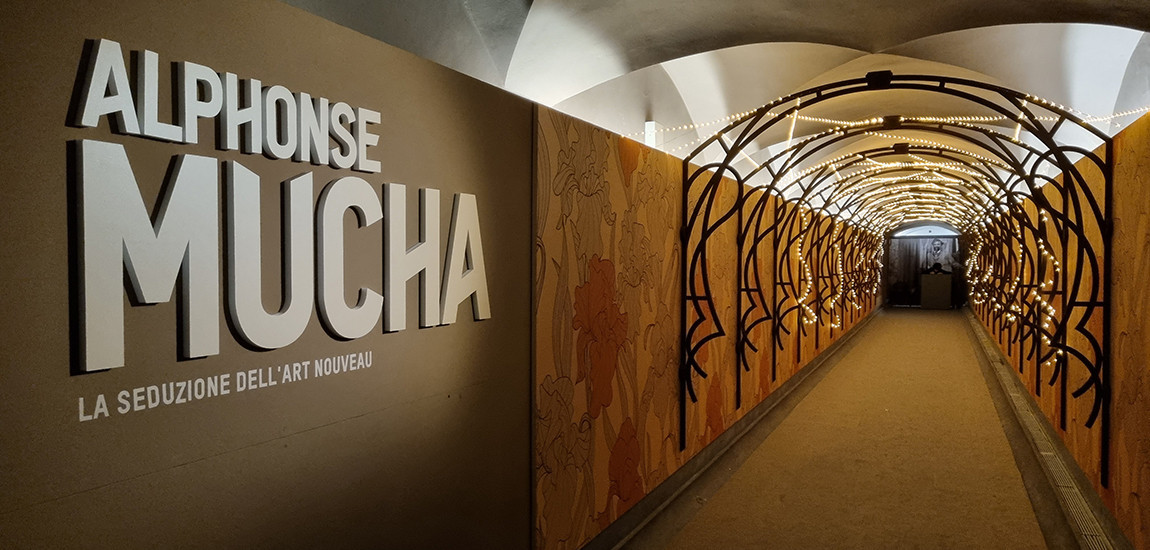
Alphonse Mucha, the Seduction of Art Nouveau in Florence
Between
the end of the 19th century and the beginning of the 20th century, Paris was
the center of the art world, it was the Belle
Époque and almost all the new artistic trends started from the French
capital.
Photography
and cinema gave a new cut to images and allowed us to show the world from new
points of view, filling the public with wonder. World industry was expanding,
railways and large ships were reducing distances. New technologies made daily
tasks easier and industrial production possible at low costs. More was being produced
and for a wider segment of the population, therefore people were also buying
more, consequently irt was rendered necessary to be able to sell products
better. Advertising posters were born, and were greatly influenced by Japanese
prints.
It
is in this historical context that reached popularity the Czech artist Alphonse Mucha, painter, sculptor and
graphic designer, protagonist of the exhibition at the Museo degli Innocenti in
Florence until 7 April: Alphonse Mucha. The seduction of Art
Nouveau.
Mucha
developed a unique and iconic style, still loved and recognized throughout the
world today, which always places at the centre the female figure: strong,
charismatic and of great elegance. His women are sensual and innocent at the
same time, icons of timeless beauty.
In
Western culture, the concept of woman began to change during the Belle Époque.
While until then women were seen and represented as a docile, passive, pure and
domestic creatures, between the end of the 19th and the beginning of the 20th
century, art began to provide a more progressive concept of ideal femininity.
The woman of the new century is progressive, modern, an increasingly active
subject in the public sphere and a participant in social activities.
Mucha
promoted this new femininity, placing women at the center of advertisements for
commercial products that were once typically associated with the male sphere: active
and athletic women who rode bicycles, drunk alcohol and smoked, women who were
emancipating and who no longer only stayed at home but also lived outside,
among the people.

One woman in particular became his muse par excellence, the actress Sarah Bernhardt, met in Paris in 1985, when Mucha, who was still unknown in the world of advertising posters, was commissioned to design a poster to promote the theatrical comedy "Gismonda".
The originality of the composition, the elegant lines, the unusually long format of the poster and the pastel colors immediately met with enormous success and also earned the admiration of the "Divine" Sarah who offered the artist an exclusive contract for six years, both as illustrator and as artistic director for the works she interpreted.
The collaboration between the two brought them both great fame, Mucha became the most sought-after graphic designer of the time and Sarah Bernhardt became a renowned theater star.

Mucha's language tooks inspiration from various sources: Japanese prints, Pre-Raphaelite paintings, the forms of nature typical of all Art Nouveau, and Byzantine and Slavic decoration.
It is a unique and immediately recognizable style and companies competed for it to advertise their products. Mucha created renowned advertising campaigns such as those for Moët & Chandon champagne, Nestlé chocolate, and JOB cigarettes.
In 1904, Mucha left France to follow his ideals and arrived in New York on the transatlantic La Lorraine. His fame preceded him to America where he immediately found fortune, receiving several commissions as a portraitist, teaching in New York, Chicago and Philadelphia and managing to set aside a large sum of money to finance the great project he had had in mind for some time.
Therefore, in 1910 he returned to Prague where he dedicated himself for almost twenty years to the pictorial cycle of the Slav Epic, considered his greatest masterpiece: a colossal work, completed in 1928, which recounted the main events of Slavic history in twenty enormous canvases.
The exhibition itinerary at the Museo degli Innocenti is divided into six sections, which chronologically retrace Mucha's artistic career and life, and then concludes with a section dedicated to the development of the language of Art Nouveau in Italy, celebrating one of the most important artists Florentines of the time, Galileo Chini.
A truly unmissable exhibition, where beauty and elegance are the protagonists, in typical "Mucha style".




